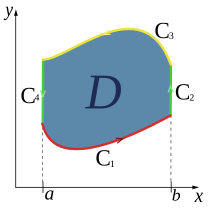This article deals with Green's integral theorem of the
plane . For more sentences named after George Green see under
Green's formulas .
The Green's theorem (also Green-Riemann formula or lemma Green , occasionally set of Gaussian Green ) allows the integral over a flat surface by a line integral express. The theorem is a special case of Stokes' theorem . It was first formulated and proven in 1828 by George Green in An Essay on the Application of Mathematical Analysis to the Theories of Electricity and Magnetism .
Formulation of the sentence

Compact
D in the xy plane with smooth edge
C in sections .
Let be a compact in the xy-plane with a smooth edge in sections (see figure). Let there be continuous functions with the partial derivatives and also on continuous . Then:







Here means the line integral along of , so if by a piecewise smooth curve will be described. The definition is analogous .





![\ gamma = (\ gamma _ {x}, \ gamma _ {y}): [a, b] \ to C](https://wikimedia.org/api/rest_v1/media/math/render/svg/05ebb804a200cf9528513b545de044dfe216614b)

Special case of travel independence
For the special case that the integrand
in the curve integral on the right represents the total differential of a scalar function , i.e. H. it is and
follows after the
set of black (interchangeability of the sequence of discharges of after and ) that









have to be. This
means that the area integral on the left and thus the curve integral on the right become zero over the closed path, i.e. H. the value of the function has not changed.


Such path-independent, two-dimensional functional changes occur, for example, in thermodynamics when considering circular processes , in which case it stands for the internal energy or the entropy of the system.

For three-dimensional scalar potential fields , such as those used in mechanics, e.g. If, for example, the conservative force field of a Newtonian gravitational potential is described, the path independence can be proven similarly via the more general Stokes theorem.


Application examples
Area
If one chooses and , the partial derivatives are and . The integrals then describe the area of , which is uniquely determined solely by the course of the boundary curve and can be calculated by a curve integral instead of a double integral:






If you choose and , you get analog



Adding the two results gives the Leibniz sector formula for a closed curve:

Centroid
If one chooses and , the partial derivatives are and . Then one can calculate the coordinate of the center of gravity of the surface by a curve integral:







Correspondingly, with and for the coordinate of the center of gravity of the area :





This principle is also used in planimeters or integrimeters to determine area and area moments of a higher order.
literature
-
Otto Forster : Analysis. Volume 3: Measure and integration theory, integral theorems in R n and applications , 8th improved edition. Springer Spectrum, Wiesbaden, 2017, ISBN 978-3-658-16745-5 .











![\ gamma = (\ gamma _ {x}, \ gamma _ {y}): [a, b] \ to C](https://wikimedia.org/api/rest_v1/media/math/render/svg/05ebb804a200cf9528513b545de044dfe216614b)


























